The Flamingo Land planning application & the LLTNPA’s investment programme
On 29th April the Loch Lomond and Trossachs National Park Authority (LLTNPA) sent a letter (see here) to all those who had commented on the revised Flamingo Land Application advising them that new documents, some of which it had held back for over six months, had been added to the planning portal and there were 30 days to respond. The letter did not make it clear that the 30 days was the statutory minimum periods for comments or that the LLTNPA’s usual practice is to accept comments on an application up to the time it is decided. The range of the documents added, which include not just further information from Flamingo Land but responses from public authorities, suggests that two years after the revised application was first submitted officers may be getting closer to being able to ask the LLTNPA Board take a decision.
Given this, it is strange there is no mention of the Flamingo Land application in the open part of the LLTNPA Board Meeting on Monday 10th June (see here for papers), although it could be being discussed at the secret session being held in the afternoon. This omission is even stranger because agenda item 12 (see here) reports two substantial public investments affecting the Riverside Site, the core part of Balloch affected by the proposed Flamingo Land Development:

How the masterplan being proposed for the pierhead at Balloch, an area which LLTNPA senior management had – without board agreement – allowed to be included in the previous Flamingo Land application, fits with the current application is not explained. There is not even an explanation of whether the masterplan is intended to address the concerns that LLTNPA frontline staff raised about the implications of the Flamingo Land for the pierhead area (see here). Without any explanation, justification or democratic scrutiny, the LLTNPA’s senior management have found and are committing significant public funds to the area:
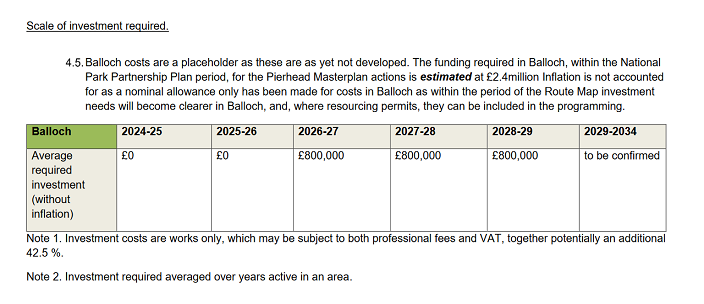
Without any explanation or justification this £2.4m stinks. It comes on top of all the public money committed by Scottish Enterprise (see here) designed to help the Flamingo Land development go ahead.
Of equal concern there is no mention in the paper of what the LLTNPA senior management team are planning for “sustainable transport, public realm or connectivity” and no mention of the levels of investment being considered. That is DESPITE the undoubted traffic and parking problems which will be created if the LLTNPA allow Flamingo Land’s development proposals to go ahead.

Balloch is the most important gateway to the National Park and the one with the most potential in terms of sustainable development. Having failed to deliver on the recommendations of the Balloch charrette (planning event) 8 years ago(see here), the LLTNPA then omitted the village from its place programme in favour of places like Luss and Tarbet. While it is a step in the right direction that Balloch is once again on the agenda for public investment, the failure of LLTNPA senior managers to explain their proposals or how they fit with the Flamingo Land planning application raises serious governance issues.
Either these proposals have been developed to assist the Flamingo Land development go ahead, which would completely corrupt or, if they are being developed in their own right, the thinking behind them should be applied to the proposed development. For example, it is impossible to see how allowing Flaming Land to create lots more car parking places in Balloch could be compatible with any public investment aimed at making transport in Balloch more sustainable. Either these issues need to be resolved before the current application is determined OR it needs to be rejected.
This failure by LLTNPA Senior Management, who helped appoint Flamingo Land as preferred developer for the Riverside Site (see here), to be open and transparent about their plans for Balloch, raises serious question about the motivation behind their recommendation at Item 9 on the agenda (see here) that the LLTNPA Code of Conduct should be revised to include a new section limiting what Board Members can say and do in respect of planning applications.
The LLTNPA’s proposed revisions to the Code of Conduct for Board Members
While the Code of Conduct Report update report (see here) introducing the proposed changes provides a short explanation of the background, this is far from clear and the proposals are presented as a technical matter without any attempt to explore their implications for democratic decision-making.
In 2015 Scottish Ministers approved a Code of Conduct (see here) for the LLTNPA which included a section (7) on “Taking Decisions On Quasi-Judicial Or Regulatory Applications”. In my view, that version of the Code was actually quite good. It required Board Members to be objective when taking decisions about planning applications and not to allow personal interests to influence decision making, but also allowed them to express views about planning policy for an area, including masterplans – hence the proposed masterplan for the pierhead should enable the Board to have a wide discussion about what sort of development would be appropriate for this area – and to give provisional views where an application is for consent in principle, as is the case with Flamingo Land:
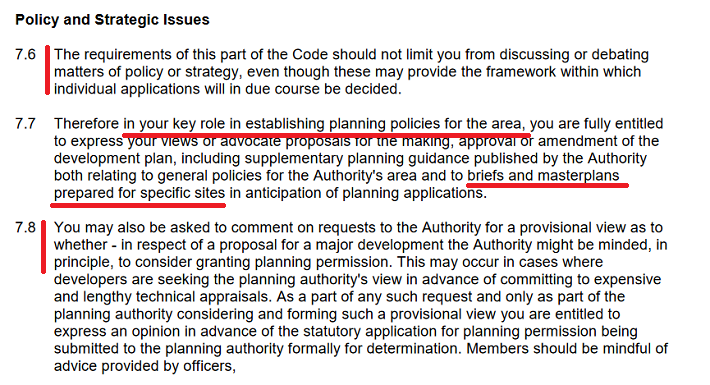
Section 7 of the 2015 Code also clearly empowered Board Members to assist members of the public who had concerns about an application, attend public events etc
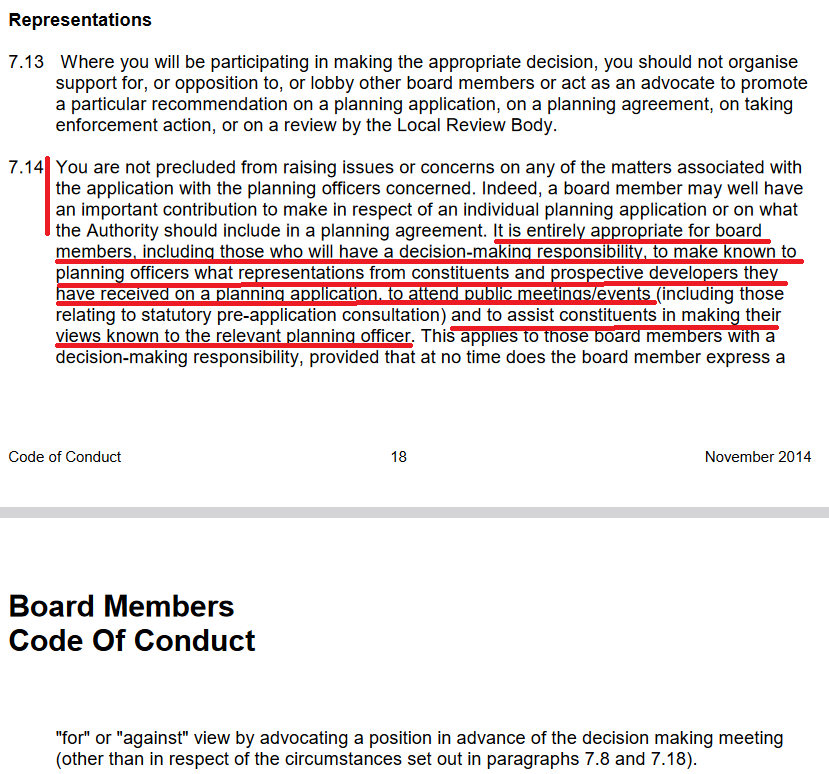
The information that senior management have put on the LLTNPA website completely contradicts this approach. It states Board Members cannot engage with the public on planning applications:

Since LLTNPA board members have no public emails and staff vet all correspondence to the generic board email, this means senior management have been preventing residents in the National Park from asking for any help from or expressing any concerns to local or other board members on planning matters. There is no legal justification for this and it provides another example of how the Chief Executive of the LLTNPA, Gordon Watson, has become completely unaccountable.
In 2022 the Standards Commission issued new model code of conduct for Councils and Non-Departmental Public Bodies (NDPBs). The Code for NDPBs had no Section 7 on taking quasi judicial decisions and consequently the LLTNPA dropped Section 7 from the revised Code they adopted in June 2022 without any consideration of the consequences. This was unwarranted but also proves there is no justification for the LLTNPA’s current message on its website that the public are not allowed to communicate with Board Members about “live planning matters” (NB that includes not just planning applications but also enforcement issues)..
While the vast majority of planning applications in the Loch Lomond and Trossachs National Park are decided by staff, the Flamingo Land application will be decided by the whole Board. That left the LLTNPA potentially exposed to the gaping hole in their Code of Conduct for Board Members. Instead of staff proposing, however, the Board should reinstate the old Section 7, they agreed with the Standards Commission that the LLTNPA should incorporate different guidance on taking quasi-judicial decisions, as set out in Section 7 of the model Code of Conduct for councillors.
That Code of Conduct is far more restrictive about what elected members can say and do about about planning applications – the planning system has been deliberately made a lot less democratic in the last ten years to favour development interests – and includes little of the advice from the 2015 Code that had allowed Board Members lots of room to speak out and raise questions about planning applications. For example, the new provisions state:
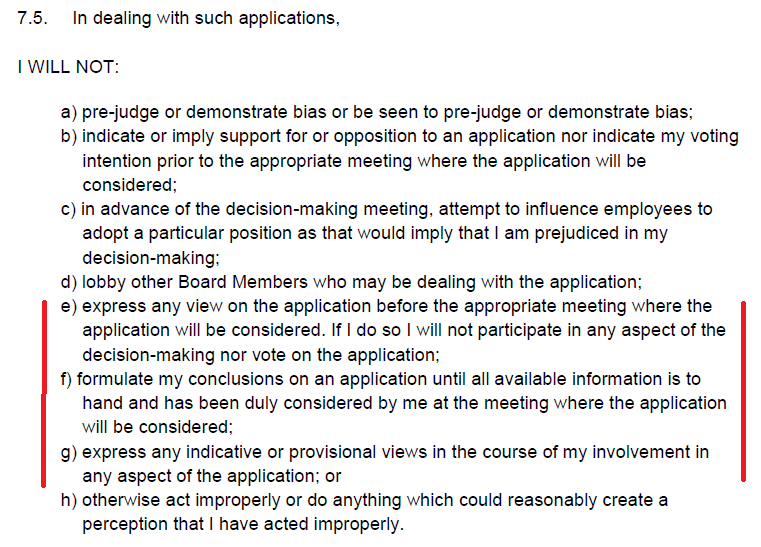
Point e) means that Board Members cannot even say that an application contains insufficient information for them to take a decision, point f) effectively tries to prohibit Board Members from thinking about an application till the decision-making meeting and point g) prevents them from saying anything about an application whatever its implications for an area, whether that is in terms of green space, carbon emissions etc. While developers are allowed to make whatever wild claims they wish about an application, those who represent local communities are allowed to say nothing:
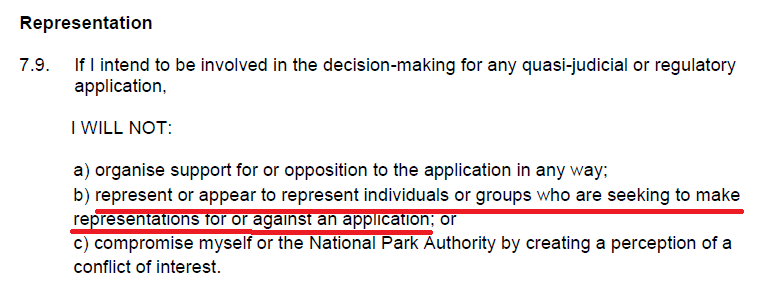
None of this is explained in the paper due to be considered by the LLTNPA Board on Monday. Given the gaping hole staff had created when they recommended the Board adopt the revised Code of Conduct in 2022, they could have given the current Board the choice of re-adopting the old LLTNPA Section 7, which had been approved by Scottish Ministers, instead of taking Section 7 from the model code of conduct for councillors. The Chief Executive, Gordon Watson, has chosen not to do so and acted in a far from open and transparent manner. Effectively his proposals could prevent ANY Board Member raising questions about the Flamingo Land application or the purpose of his proposed £2.4m investment at the Pierhead.
The consequence of these past and proposed changes to the LLTNPA Code of Conduct is to give the Chief Executive and his Senior Management Team the power to do whatever they like to assist development interests while making it increasingly difficult if not impossible for Board Members to represent the interests of local communities or wider stakeholders in the National Park.
West Dunbartonshire Council Labour group and the code of conduct for councillors
While standards in public life, as set out in codes of conduct, are being used by staff to prevent councillors and board members from supporting local community concerns about developments, different standards apply when it comes to supporting developers.
Recently 10 out of the 11 Labour Councillors on West Dunbartonshire Council (WDC) agreed to support the Flamingo Land Planning Application (see here). With the 11th Labour councillor, Hazel Sorrell, excusing herself from the council meeting that took the decision because she represents WDC on the LLTNPA, it appears Labour agreed a party political line on the application. When commenting that if Councillor Sorrell had been at any meeting which agreed a party line, she should would need to excuse herself from the LLTNPA decision-making process anyway, I failed to refer to a crucial provision in the Code of Conduct for Councillors (see here):
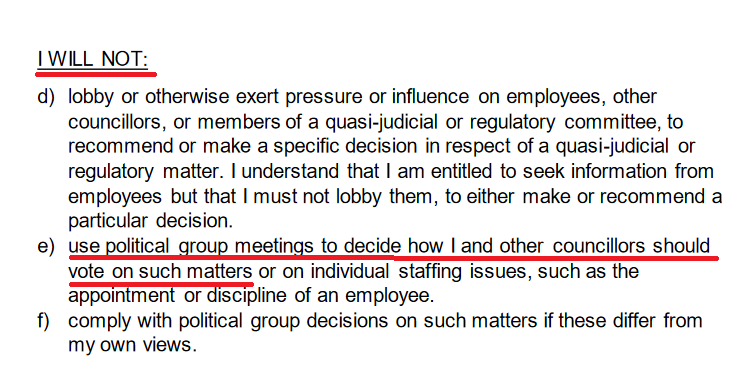
The Balloch and Haldane Community Council were rightly very angry after the WDC decision and have submitted a complaint and the conduct of the council. It seems to me there is now a very strong case for the Standards Commission to investigate how and why Labour Councillors effectively decided unanimously to support the Flamingo Land application – i.e whether they used a political group meeting to decide how to vote. The contrast with the smaller SNP group, who were split on the application, is striking. One wonders if Dr Heather Reid, the Convener of the LLTNPA Board, will now ask the Standards Commission to investigate?
Democracy, Codes of Conduct and the planning system
Board Members should in theory provide a means by which public authorities are held accountable to the wider public. While most are now part of the political class in Scotland, which unquestioningly does whatever the Scottish Government asks of them, directly elected board members on National Park Authorities could provide a means to empower local communities, like councillors on local authorities, and challenge developments like Flamingo Land. That appears to be the last thing the political class want, hence the proposals to revise the Code of Conduct for Board Members which will effectively prevent locally elected members representing their constituents. The proposal to revise the code should be seen for what it is, an attack on democracy.
There is nothing wrong about the 9 principles underpinning public life which are contained in the codes: Selflessness; Integrity; Objectivity; Accountability and stewardship; Openness; Honesty; Leadership; Public service and Respect. The problem is that the detailed provisions in the Code of Conduct, particularly in relation to taking “quasi-judicial decisions”, serve to undermine these principles. For example, being selfless should mean acting for your local community, openness should mean not hiding your concerns about an issue, public service should mean putting needs of local communities before those of developers, but Section 7 from the Code of Conduct for councillors stops all of this.
Meantime, the principles of the Code of Conduct do not apply to senior staff in public authorities who are increasingly unaccountable. he Codes of Conduct now have clauses prohibiting criticisms of staff in public, which makes it very difficult for board members or councillors to hold them to account, whatever they have done, and there is no enforceable requirement on Chief Executives like Mr Watson to act according to the 9 principles underpinning public life. This means that local communities have no means to seek redress when these unelected officials brazenly act beyond their powers (by banning communications with Board Members on planning applications for example).
Our National Park Authorities, with their provisions for locally elected members, could be helping to show the way towards a more democratic planning system in Scotland but are now doing the opposite. Before Scottish Ministers create any new National Parks they need to review how existing ones are performing. A key part of that should be about how they can be made more democratic and help empower stakeholders, including local communities, instead of putting the interests of development and developers first.
Before Scottish

As always, an excellent, well researched blog which I am sure will generate many responses. I was prompted to read some of your ‘see here’ items which are still very pertinent. In your blog article Flamingo Land’s Mark II Planning Application at Balloch (2) – impact on the pierhead area & the National Park’s response (October 8 2022
“the LLTNPA should require Flamingo Land to produce clear and detailed proposals for parking and traffic management across the site as a whole BEFORE any “Planning Permission in Principle” is considered.”
There were no clear plans submitted by the applicants for the disgraceful APPROVE decision re Inchconochan Island …. Though there were the ‘get out’ “conditions”.
With reference to the new woodland car parking – what about the impact on the existing flora and fauna is already in crisis ?
In the LLTNPA’s letter you say that It appears clearly motivated by a concern to protect boat users and their ability to enjoy the loch but in the new Navigation Byelaws they are questioning the rights of free navigation on Loch Lomond. So,you are correct in using APPEARS.Thankfully the current LLA committee are undertaking their own research on these ancient rights. Having previously revealed the LLTNPA’s involvement in the appointment of Flamingo Land as preferred developer for the Riverside Site (see here), in December 2019 (see here) I explained the extensive conflicts of interests behind the previous application and that these still require to be investigated. They never have been. …… All these conflicts of interest would have exposed the LLTNPA to legal challenge had they approved Flamingo Land’s Planning Application in 2019. ….. further explored these conflicts of interest in 2021 (see here) after Gordon Watson, the LLTNPA’s Chief Executive, falsely claimed in public that the decision to appoint Flamingo Land “was made by Scottish Enterprise alone”. No it wasn’t, the LLTNPA were on the interview panel. The Convener, James Stuart, then refused to get a Board Member to investigate this. This strongly suggests that the conflicts of interest remain. The good thing is that because of this the LLTNPA Board is likely to be open to legal challenge if they ever do approve the current application. It seems that CONFLICT is rife within the LLTNPA itself on many fronts! Re your paragraph above, I do wonder what would happen if permission was REFUSED. Could Flamingo Land launch a legal battle against LLTTNPA (and Scottish Enterprise)?? If this is possible, would that possibility be reason enough to APPROVE??
A very well researched blog, Nick, which mirrors many of my long held views on these restrictive Codes of Conduct for planning committee members in all local authorities. Frankly, why shouldn’t a planning committee member be able to express views on upcoming planning applications and proposed developments? If on the day they here more information that makes it appropriate for the planning committee member to chance his/her views, so be it.
My comparison is MSPs and MPs. I don’t see any code of conduct which restricts them from commenting and even campaigning for one side or the other prior to a vote in Parliament. If this is deemed to be part of our democracy, and freedom of speech, why then are local authority planning committee members so harshly restricted?
Yet another part of our archaic public body practices, Is any political party putting this into their manifestos to vastly improve the local authority democratic process? Not that I have seen, instead they are all intent in playing at scoring little points against each other which they think will attract media and public attention.
Is it not about time the Scottish government stepped in and took note of the 90,000 local people who live and work in the Balloch area that objected to this Flamingo land fiasco? Who runs this country? Surely it must be those persons whom we voted for at elections and not those appointed to committees by lord know who? They are clearly not doing what local residents want, so they ought to be removed from office, first one being Gordon Watson who seems to be running things for his own ends.
Give yourself a shake Nicholas, the Government isn’t going to step in,
Who do you think approved the appointment of Gordon Watson?
Let me save you 30 seconds on Google.
It was Aileen McLeod in her capacity as Minister for Environment, Climate Change and Land Reform.
Our incompetent, dishonest, gravy train riding SNP Government facilitate this.